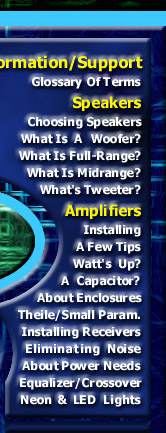




Technical
Help
& Education
Glossary Of Terms
Speakers Main Page
How Speakers Work
Choosing Speakers
What's A Woofer?
What's A Midrange?
What's A Tweeter?
Other Speaker Types
More Speaker Types
What's A Capacitor?
Installing A Capacitor
What's A Crossover?
What's An Equalizer?
Speaker Enclosures
Theile/Small Param.
About Power Amps
Installing An Amp
Installation Tips
Power Ratings
Installing/Replacing
Head Units/Receivers
Installing Neon/LED
Eliminating Noise
Use The Right Tools
Manufacturer's
Links
Personal
& Marine
Electronics
Laptop Computers
Cell Phones & PDAs
Portable TV & Video
Electronic Readers
MP3/Music Players
CD
Players/Booms
Earphones/Buds
Digital Cameras
Video
Cameras
Personal GPS
Bluetooth
Calculators
Accessories
Marine
Electronics
Stereo Amplifiers
Stereo Speakers
Stereo Woofers
Enclosed Speakers
TVS & Video
CD/Mp3 Receivers
GPS & Navigation
Fish Finders
Accessories
Home
Stereo &
Office Electronics
Flat
Screen & HD TVs
Surround Sound
Home Theater
DVD Players/Tivo
DVD Recorders
Blu-Ray Devices
Amplifiers/Tuners
Speaker
Systems
Subwoofer Drivers
Midrange
Drivers
Tweeter Drivers
Powered Subwoofers
Outdoor
Speakers
Stereo Accessories
Digital
Photo Frames
Video Game Systems
Game
Accessories
Video Games
Home Security/Alarms
Computer
Products
Desktops & Laptops
Add-Ons/Peripherals
Computer Monitors
Computer Software
Computer Games
Printers &
Scanners
Ink/Specialty Papers
Parts & Components
Computer Supplies
Security/Tech
Support
Auto
Electronics
Amplifiers
Subwoofers
Full-Range Speakers
Midrange Speakers
Tweeters
Power Capacitors
Empty
Enclosures
Loaded Enclosures
CD/Mp3 Receivers
CD Changers
Bass Packages
Car
TV & Video
Satellite
Radio
Bluetooth Wireless
GPS Navigation
Neon/LED Lighting
Radar Detectors
Chrome
Mufflers
Car Alarms/Security
V
AUTO
PARTS STORE
Auto
Wiring &
Accessories
Air Horns
Power
Antennas
Antenna Boosters
A/V Controllers
Bass Blockers
Crossovers
Dynamat
Equalizers
Fans (Cooling)
FM Modulators
Interfaces
Line Converters
Noise Filters
Power Inverters
Power Supplies
RCA Cables
RCA Splitters
Remote Controls
Signal Boosters
Vibration Control
Speaker Grills
Wiring Kits
Practical Tips For Installing An Amplifier
An adequate
power source for your amplifier is one of the most essential elements
for good sound reinforcement: especially in bass response and high
amplitude peaks. Add extra snap, punch, and critical clipping prevention
to your sonic power, by installing a
capacitor
that stores a large amount of voltage that can be discharged any time
the voltage available from the battery drops below the stored voltage
set point. But never use any amplifier beyond it's rated capacity,
else it will produce clipping even with a capacitor.
Dress the positive (+) red wire directly from the battery to your
amplifier. Position the wiring through the vehicle so it is not crimped,
nor likely to be disturbed.
One strategy is to run the wire under the vehicle inside of neoprene
hose, PVC pipe, or conduit. Be careful where you put this wire if
you plan to do an outside run. If your vehicle is an off road type,
try to run the wire inside a frame or at least along it, to avoid
getting it caught on anything that might snag it along the bottom
of the vehicle.
Avoid drilling holes in the frame. Most of the time, you can find
pre-existing holes in which to run and attach wiring. Holes in the
frame can cause cracks to form over time. If you must drill a hole,
drill it close to the center, rather than the edge of the member.
At the point where you decide to run the cable up into the vehicle,
be sure to check for obstructions and other wires that you may drill
into. Use a grommet to insulate the drill hole from the wire. You
may find rubber inserts in some trucks into which you can punch a
hole as well.
Always use the fuse on the red wire as close to the battery as possible
and wait to put the fuse in as the last step of the installation.
If any short circuits appear in your wiring, the fuse will blow.
For the best system integrity, it is advisable to solder all connections.
If you know how to solder, you can skip this section. For doing solder
jobs on wiring, you will need a 50 watt iron or higher. Use rosin
core solder, not acid core! Strip the wire back; carefully separate
the strands by lightly pushing on the end of the wire and twisting
back and forth lightly! If soldering to a connector, insert the wires
together on center till it stops. Now squeeze and twist them lightly
together. Crimp the connection loosely. Use a ceramic dinner plate
to solder on. Put the wires, or wire and terminal on the plate and
heat the work. Let the parts to be soldered melt the solder, rather
than the iron. Start rubbing the solder on the bottom side of the
iron and on top of the wire, so you will be rubbing along the point
of contact of the iron and the wire. Now place these on the plate
and heat the crimped part of the connector and let it flow over the
wire connection joint.
You can also run power wiring under panels, tracks, and carpet. But
make sure your wires aren't placed where a screw can go through them
and cause a short. Run power wire well away from the RCA signal cable.
DC power wiring can carry induced signals that may leak to the signal
carrier and be heard as clicks, noise, pops, or alternator whine.
Also, we recommend that you ground all peripheral components other
than the head unit, to the same point. This will prevent ground loop
hum. If possible, use a convenient grounding point already in the
frame of the vehicle. Take a wire brush or sand paper to clean paint
and corrosion from the metal to reveal a conductive metal shine before
making your connection. Here again soldering is recommended.
Don't forget to run the remote wire with the power wiring. It connects
to the blue (power antenna) wire on many head units (receiver). But
refer to your receiver's instructions, for the precise wire to use,
to remotely turn the amplifier off and on from the receiver.
Be sure to cover all exposed connections with a wire nut, and then
electrical tape - wrap tightly! Good Luck!
MAIN
PAGE
GLOSSARY
SPEAKERS:
Choosing
General
Woofers
Miidrange
Tweeters
Full-Range
Full-Range 2
CAPACITORS
CROSSOVERS
EQUALIZERS
Theile/Small
AMPLIFIERS:
About
Installing
Install Tips
Power Ratings
RECEIVERS:
Installing
NEON/LED:
Installing
TOOLS
Home
--
Policies
--
Products
--
Tech
Center
--
Auto
Electronics
--
Home
Electronics
--
Personal
& Marine Electronics
--
Stereo
Tech Info
Website Designed & Maintained by
MetroDirect
Communications
Copyright (c) 2000 - 2009
Electronixwarehouse.com
.
Use of any material appearing on this site without specific written
permission is prohibitied by law.
electronixwarehouse.com
---
logobannerfactory.com
---
bleepthem.com (Political Satire)
---
rlebeaux.com
---
stereotechnicalinformation.com (Stereo
Technical Help)
---
electronixwarehouse.net
---
thespeakerstore.com
---
wmpublishing.com (Help For Writers)
---
barbarathenovel.com
---
cutethenovel.com




